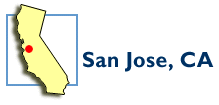San Jose, CA
More Success Stories
Getting Started: Why Pay-As-You-Throw? | Educating the Public | Getting the Prices Right | Managing the Program Costs | Success: Waste Reduction and Increased Recycling
We worked to educate residents away from the concept of unlimited garbage toward the idea of unlimited recycling.
Getting Started: Why Pay-As-You-Throw?
San Jose is the nation's eleventh largest city. Our residents are among the most educated and affluent in the country and represent a diverse community, with the two largest minority groups being Latino (27 percent) and Asian (14 percent).
San Jose, CA
- Population: 850,000
- Type of Community: Urban
- Type of Program: Four-sort
- Program Start Date: July 1993

Before July 1993, San Jose provided unlimited weekly garbage collection service at a flat monthly rate of $12.50 per household. Residents set out an average of three 32-gallon garbage cans per week. The city fully implemented its Recycle Plus (RP) residential integrated waste management program for 186,000 single-family dwellings on July 1, 1993. This program was designed to permit the city to reach its California Integrated Waste Management Act goal of 50 percent waste reduction by 2000.
The new RP program resulted from over 3 years of planning that included extensive research on all major policy changes. This program includes a fully automated garbage collection system, an aggressive PAYT rate structure, a four-sort recycling system, and a contractor payment mechanism which provided financial incentives that encourage contractors to promote recycling.
Educating the Public
The public was involved in the design of the RP program through a questionnaire mailed to all 186,000 households; community meetings throughout the city; pilot projects in 17 neighborhoods for collection of yard trimmings and mixed papers; and the use of a public review committee to select the firms that would be given 6-year collection contracts for the collection of garbage and recyclables and for recyclables processing.
"In the three years since our program began, an average of 87 percent of residents have requested 32-gallon cans-the smallest size we offer." - Jo Zientek, Supervising Environmental Services Specialist, 408-277-5533
A comprehensive public outreach campaign aimed at single-family households explained the new variable rates being introduced, the new categories of recyclables being added to the services provided, and the benefits of participating. All materials were produced in three languages (English, Spanish, and Vietnamese). The campaign was guided by the information received during a series of focus groups in the three languages, baseline and follow-up telephone surveys, and shopping mall intercept surveys. More than 250 community meetings were held in 1993, and a block leader program and school education program were organized.
Getting the Prices Right
Staff began researching unit-pricing structures for the new RP program in the spring of 1992 through surveys and interviews with successful PAYT communities nationwide. Residents were offered 32-, 64-, 96-, and 128-gallon carts with an "aggressive" unit-pricing structure. This structure provided a slight price break for each additional 32 gallons of capacity at the 64- and 96-gallon level, which the council considered important to help residents make the transition from flat rate to unit pricing.
We had to ensure that we had sufficient quantities of wheeled-garbage carts in the sizes the residents would request. We sent out a return-reply card to all single-family households in January 1993 with our estimated rates, and let residents know that no reply would result in delivery of the default 32-gallon cart.
Staff was able to work out a compromise with the city council, which included offering one of the most comprehensive low-income rate assistance programs for garbage service in the state. Criteria were based solely on household size and income and permitted eligible residents to receive a 30 percent discount on their bill. About 3,400 households currently participate in this program.
Managing the Program Costs
The challenge faced by the program is to both continue and expand its multi-pronged recycling efforts to meet diversion goals, while reducing costs to close the projected $5 million cost-to-revenue gap in five years. The city already has reduced costs by over $4 million annually through contract renegotiations that resulted in extending the term of the RP and yard-trimming collection contracts from June 1999 to June 2002.
Success: Waste Reduction and Increased Recycling
Staff did not anticipate how quickly residents would change their recycling participation to accommodate the 32-gallon size cart, especially since prior to RP the average set-out was three garbage cans. Since RP implementation, an average of 87 percent of residents have requested the 32-gallon size.
The difference between the "before and after" garbage set-out volume could readily be found in the quantity of recyclables collected in the new RP program. The volume of recyclables and yard trimmings being collected more than doubled the levels recorded prior to RP. Most importantly, residents reported wide satisfaction with the program and its results (80 percent in 1993 to 90 percent in 1996. Figures are based on a random sample telephone survey).
More Information
- View and print this success story (PDF) (2 pp, 112K, about PDF).
- To order a complete set of Pay-As-You-Throw Success Stories free of charge, call 1-888-EPA-PAYT or access our online order form.
![[logo] US EPA](../gif/logo_epaseal.gif)